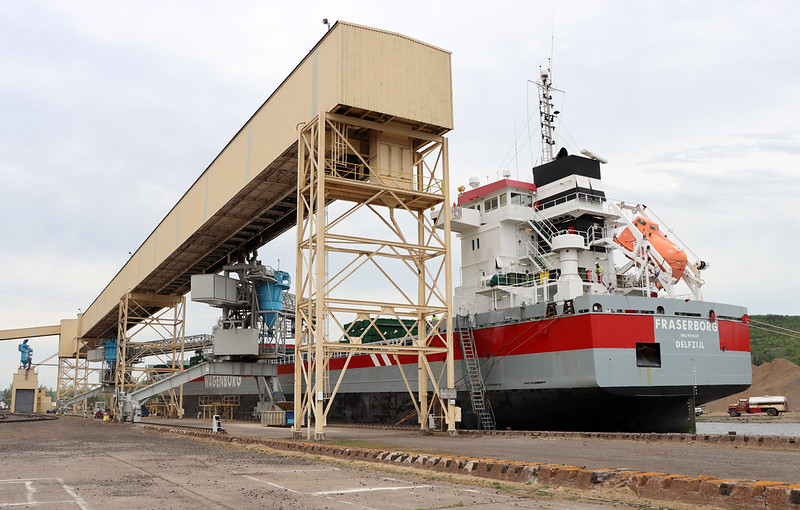With harvests underway, U.S. grain shipments through the St. Lawrence Seaway saw a bump in September, a positive note during an otherwise difficult 2020 shipping season. U.S. grain shipments (from April 1 to Sept. 30) have reached 1.1 million metric tons, an increase of more than 4% over the same time period a year ago.
“U.S. grain shipments are increasing with the new mid-west soybean harvest being shipped to Europe and North Africa,” Bruce Burrows, president and CEO of the Chamber of Marine Commerce, said in a prepared statement. “We expect that will continue through the remainder of the shipping season.”
Overall, nearly 23.3 million tons of cargo has moved through the Great Lakes–St. Lawrence Seaway system this year, down 8% from 2019, with the pandemic and a late start to shipping due to high water levels as the main factors.
Burrows also noted that general cargo shipments have been holding steady, driven by wind turbine components being shipped for wind energy projects throughout the Great Lakes. Some ports have also been receiving steel slabs from Europe and Brazil for further processing before being used in automotive manufacturing. St. Lawrence Seaway shipments of iron ore, liquid bulk and dry bulk continue to be down due to the economic repercussions of the pandemic.
Across the Great Lakes, U.S. ports also reported mixed results.
Through September, tonnage at the Port of Toledo has surpassed 6 million tons. “So far, we have seen significant gains in aluminum and iron ore while coal and dry bulk are lagging behind,” said Joseph Cappel, VP of business development for the Toledo-Lucas County Port Authority. Unique cargo handled at the Port of Toledo in September included cement clinker and corn gluten feed pellets. “We are very encouraged by the opportunity to handle any new commodities and are glad to see grain tonnage surpass last year. We expect brisk grain trade for the remainder of the shipping season.”
The Port of Duluth-Superior’s year-over-year tonnage comparison improved by seven-tenths of a percentage point last month, but that incremental gain still leaves the 2020 total some 30% behind last season’s pace through September. General cargo tonnage, comprised primarily of wind energy cargoes, remained a highlight at the port, up 29% over last season and 65% over the five-season average. Likewise, outbound grain continued its strong season, outpacing the 2019 rate by 10%. Some 452,000 tons of limestone also helped fuel the September uptick, a float which ranked as a five-season September high for the inbound carbonate rock.
“September 2020 was the third-consecutive month of tonnage totals above 2.8 million, and while that is well below the usual monthly totals, it’s still a hopeful sign of improvement from the pandemic-induced lows of late spring,” said Deb DeLuca, executive director of the Duluth Seaway Port Authority.
Steel shipments have had an impact on the Port of Indiana-Burns Harbor. “While 2020 has been a very busy year at the Port of Indiana–Burns Harbor in terms of general and project cargo shipments, the Covid-19 pandemic has certainly stifled demand for steel products throughout the world, including Northwest Indiana," said Port director Ian Hirt. "Through the end of August, year-to-date steel shipments through the port are down 8.9 percent. In September, the port saw waterborne steel cargoes from Belgium and Holland as well as cross-lake shipments from Canada.”
“In a year of big challenges, Port Milwaukee cargo volumes are holding steady,” said port director Adam Tindall-Schlicht. “Total cargo is up a fraction of one percent through September, led by dry bulk commodities. In a year marked by pandemic, economic downturn, and damage from high water levels in Lake Michigan, we continue to provide important services to our customers.”
Earlier this month, Tindall-Schlicht was named an international winner of the AntwerpXL 40 Under 40 Award for his contributions to the global breakbulk market.
The Port of Green Bay saw a nice uptick in cargo shipments in September compared to July and August. The year-to-date totals, however, still lag behind last year (-21%) at 1.28 million tons.
“This is proving to be a difficult year for shipping on the Great Lakes,” said Dean Haen, port director. “Petroleum product shipments have fluctuated significantly, and coal imports are down appreciably. With just a few more months left in the 2020 shipping season, it will certainly be a challenge for the port to reach its goal of 2 million tons of cargo. We need to see an uptick in coal, salt and petroleum product shipments to have a chance to hit that mark.”



.JPG.small.400x400.jpg)

